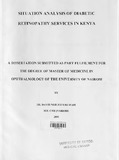| dc.contributor.author | Ekuwam, D N | |
| dc.date.accessioned | 2013-05-23T07:41:36Z | |
| dc.date.available | 2013-05-23T07:41:36Z | |
| dc.date.issued | 2008 | |
| dc.identifier.citation | Master of medicine in ophthalmology | en |
| dc.identifier.uri | http://erepository.uonbi.ac.ke:8080/xmlui/handle/11295
/24653 | |
| dc.description.abstract | Objective: To analyze the situation of diabetic retinopathy services in Kenya.
Design: Cross-sectional hospital based study.
Setting: Medical out-patient clinics and Eye units.
Subjects: A total of eighty facilities across the country were reviewed between May and October
2008 .All District Hospitals and eye units run by the Government were included in the study. All
NGO/Voluntary facilities providing general health as well as eye care services were also
included, whereas private for profit health facilities were excluded for logistical reasons. Key
informants were identified from medical outpatient clinics and eye units and interviewed on their
health facilities' capacity (personnel, infrastructure, equipment, and supplies); services delivery;
referral and linkages with respect to diabetes mellitus and diabetic retinopathy services.
Results: All eye units in the country were covered while 80.3% coverage was obtained for
district hospital. Ten per cent (10%) of the facilities were run by NGO/Voluntary organizations
whereas 90% were Government facilities. There was a skewed geographical distribution of
facilities since 72.5% were found in half of the provinces namely Rift-Valley, Coast, Eastern and
Central provinces. Diabetics constitute about 8.0 % of all medical outpatients in Kenya. Nairobi
had the highest number of diabetics 17,454 (24.5%) and North- Eastern province the lowest at
1,060 (1.5%). 79.0% of known diabetics are found in Rift-Valley, Central, Nairobi and Coast
provinces. About 28.8 % of all diabetics are referred to eye care specialists for screening for
diabetic retinopathy. Central province referred 34.3 % of their diabetics to eye care specialists for
evaluation whereas Nyanza referred only 15.7 %. Diabetics are mainly managed by general
practitioners and general clinical officers who partner with nutritionists, ophthalmologists and
ophthalmic clinical officers. Screening for diabetic retinopathy is performed mainly by
ophthalmologists and ophthalmic clinical officers by dilated direct ophthalmoscopy. Accurate
grading of diabetic retinopathy poses a challenge to most clinicians including many eye care
workers as there is no uniform grading system in use as an acceptable minimum standard for
assessing diabetic retinopathy. Nairobi was found to have the highest prevalence of diabetic
retinopathy of 40.0% while North-Eastern had a prevalence of 9.2%. The median national
prevalence of diabetic retinopathy in selected health facilities is 15.4%. The number of diabetics
seen in the eye clinics is higher than the number referred from medical outpatient clinics. These
findings may be due to large numbers of diabetics arising from self referrals and early. Most eye
care workers recognize PDR (93.8%) and CSME (86.2%) as indications for retinal laser
photocoagulation. All eye units eventually referred patients with diabetic retinopathy to either
Kenyatta National Hospital or Kikuyu Eye Unit for laser or vitreo-retinal surgical interventions
Conclusion: The distribution of diabetic retinopathy services poses a challenge for prompt
treatment and specialist review. Organization of effective referral chains between primary,
secondary and tertiary eye care workers and public health measures aimed at prevention of
diabetes and visual loss is needed.
Recommendations: There is need for diabetic eye health training and re- training among health
care providers and adoption of uniform guidelines regarding grading and referral threshold for
diabetic retinopathy. In view of the skewed distribution of treatment facilities, the threshold for
referral could be lowered besides availing laser at secondary level facilities. The role of mass
media and research in combating blindness has not been fully exploited. | en |
| dc.description.sponsorship | University of Nairobi | en |
| dc.language.iso | en | en |
| dc.title | Situation analysis of diabetic retinopathy services in Kenya | en |
| dc.type | Thesis | en |
| dc.description.department | a
Department of Psychiatry, University of Nairobi, ; bDepartment of Mental Health, School of Medicine,
Moi University, Eldoret, Kenya | |

